Resuscitation of old acoustics, instead of buying a new Chinese
Not long ago, I was puzzled by the choice of acoustics for my PC. And I was puzzled because earlier I had a Radiotehnika S30 + sub with 75 Wt RMS and I wanted something in power no less.
As a result of searches on the Internet, as well as walking through all the shops of the city, I stopped at a few models that I was satisfied with on price and performance. .
1. Microlab PRO 3 - $ 127
2. Edifier C3 - $ 132
3. Logitech Z-2300 - $ 170
4. Edifier DA5000 Pro - $ 200
5. Microlab N-500 - $ 243
')
I didn’t find Edifer in the city at all, although the acoustics are pretty good with my money. Microlab PRO 3 sounded good, but the amplifier was obviously weak, and the reviews on the Internet are not particularly pleased with respect to reliability. The sound is pleasant, but something is missing. Logitech Z-2300 was noted for excessive bassing, medium work is good, but at low power. The Microlab N-500 did not like the sound of the sub.
And then I remembered the Soviet speaker systems, in particular the S90 and Amfiton. I didn’t like the S90 outwardly, so I went in search of Amphitons. At the local radio market, it was possible to find 25AS-027 in far from the best condition. Initially, the seller wanted 75 cu, but after a short conversation, it was possible to pick up a rarity for 40 cu.
I brought them home, disassembled ... and realized ... I realized that I got ... they needed considerable restoration: the woofers were already taped, one of them slightly distorted the sound at a higher average average, the baskets of the midrange were killed, instead of their native twitter - Chinese trash, no crossovers.


Therefore, I had to do a complete rework, which was not originally planned at all.
Because apparently, the “boxes” were already about 20 years old, I decided to strengthen the body. Moreover, the new low-frequency speakers had to stand compressor CW1002CX .
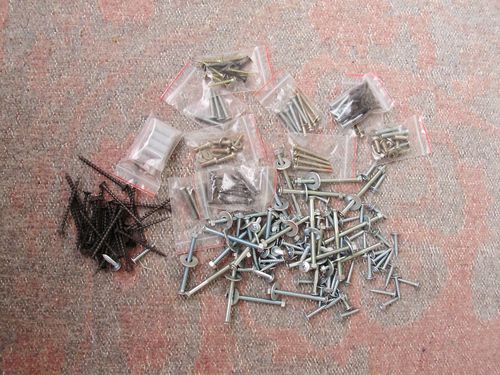
The bass heads were really tight. The first option was the DW100K with a Kevlar suspension, but could not find them, as well as the 4-ohm LW1000. But eventually LW1000A8 settled in boxes with an aluminum basket.

The characteristics suited me perfectly: 130 Wt RMS in nominal mode, a SPL of 93 dB and a frequency range of 27–4000 Hz.
The midtons left the original ones (more precisely, they initially took new ones, but they didn’t fit in size and I returned them), I don’t honestly say the labeling, because I didn’t find them, well, okay. True had to make new enlarged baskets for midrange. The basis was a dense cardboard on which flax-based material, pre-impregnated with PVA glue, was applied layer by layer. The result was about 1.8 liters for the mid-head, which gave her more room for maneuver, additionally the basket was filled with fluffed cotton.
The inner surface of the boxes was completely treated with liquid glass adhesive in two layers, which made it possible to strengthen the wood structure and close the cracks that could cause a whistle due to excessive pressure.
Between the front and rear panel of the ball a powerful oak spreader 40x60mm is installed. Fastening method - Titan glue, additionally 80-mm red-hot screws - 1 on the front panel and 2 on the back.
Also on the perimeter of the whole case, red-hot screws (about 40 per box) were screwed in, which provided greater rigidity. This step was necessary because Initially, during assembly, the box was simply glued together at the factory, and given the assembly date, doubts arose about the reliability.

Twitter unfortunately relatives could not be found, initially used isodynamic heads 10GI-1. Therefore, a hefty hole had to drown. Their place was taken by primitive piezo TE140 .
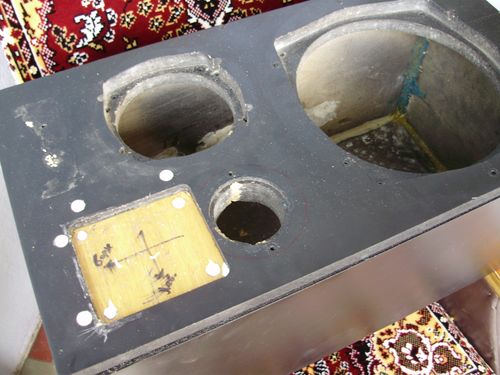
In principle, silk twitter was a good option, but the problem is that the majority of the frequency range is up to 16-18 kHz. Another best option was 4 bands, of which 2 Twitter - silk + piezo, but in the first place there are already few places, and secondly filters for 4 channels are a rarity and expensive pleasure. Although if you try hard, you could turn on the piezo sequentially through a capacitor, and silk tweet directly to the 3-channel. And then a new problem appears - impedance.
Therefore, I put a simple piezo. In practice, we get saturated high. Although - an amateur, because the piezo feeds HF more in C-tones, and silk tweets in C-tones, more tolerable to the ear. By the way, on the disco speakers it is just the same piezo and installed.
The standard phase inverter did not suit me, especially since it was planned to produce damping, which in the end significantly reduced the volume. Therefore, I installed professional telescopic tubes 65 mm in diameter. With the calculation of the length of the pipe, I did not bother, left the base 120 mm, and as it became clear later, I guessed right.

There are no dividing standard filters, so I had to look for a way out that became the 3-way PYRAMID CR48 Gold Series crossovers

Old cables were thrown to the dump, and they were replaced by copper with a section of 2x1.5mm. Unfortunately, the banana plugs could not be found, so simple clamps were installed on the back wall. In the future, "bananas" are all planned.
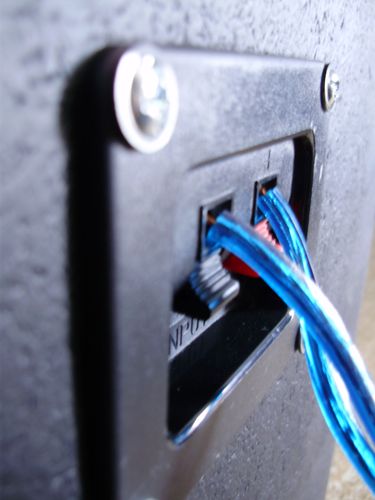
As a result, all this was put together, twisted, welded and sealed ... clay.
The inner space was damped as follows: 2 layers of foam rubber were glued to the side, top, bottom and rear panels with a felt coating with a total thickness of about 40 mm.

The boxes were plastered with car putty, sanded and painted with matt black paint with acrylic varnish.

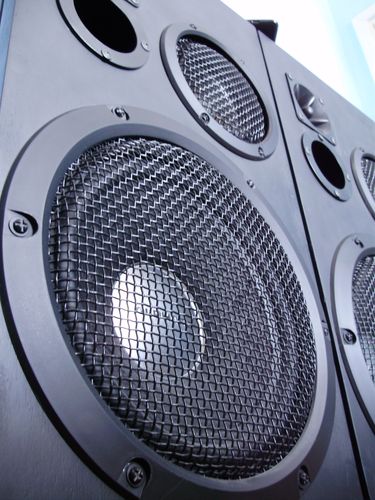
+ for the speakers themselves are 40 cu
+ 2 subwoofer 95 cu
+ twitter 5 cu
+ crossovers $ 30
+ pipes / phase inverters 18 cu
+ speaker cable 5 cu
+ bolts, screws 12 cu
+ glue, putty, 2 cans, sandpaper $ 15
+ rubber feet 6 cu
+ plasticine 2 cu
- foam rubber and felt were available
- we do not consider the cost of the power tool
- flux, solder, acid also does not count
Total ~ $ 230
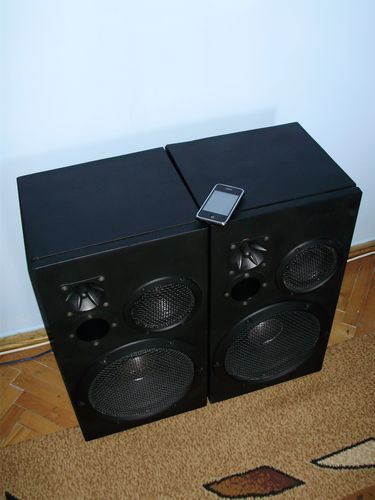
It should be noted that an external amplifier is required for this acoustics. Under the hands of which naturally was not. Therefore, it was necessary to use Gembird 2x22Wt RMS for the test.
The first connection, the first tracks ... and already at 20 Wt RMS (out of 130) it became clear that the money was not in vain. The output was a soft, rich and most importantly powerful bass, which did not interfere with midtones, pronounced tweeters, the vocals were very well developed and distinct.
Rock, Electro and Vocal have never sounded like this to me at home before. It remains only to buy a powerful amplifier.
Thanks for attention.
As a result of searches on the Internet, as well as walking through all the shops of the city, I stopped at a few models that I was satisfied with on price and performance. .
Challengers
1. Microlab PRO 3 - $ 127
2. Edifier C3 - $ 132
3. Logitech Z-2300 - $ 170
4. Edifier DA5000 Pro - $ 200
5. Microlab N-500 - $ 243
')
I didn’t find Edifer in the city at all, although the acoustics are pretty good with my money. Microlab PRO 3 sounded good, but the amplifier was obviously weak, and the reviews on the Internet are not particularly pleased with respect to reliability. The sound is pleasant, but something is missing. Logitech Z-2300 was noted for excessive bassing, medium work is good, but at low power. The Microlab N-500 did not like the sound of the sub.
And then I remembered the Soviet speaker systems, in particular the S90 and Amfiton. I didn’t like the S90 outwardly, so I went in search of Amphitons. At the local radio market, it was possible to find 25AS-027 in far from the best condition. Initially, the seller wanted 75 cu, but after a short conversation, it was possible to pick up a rarity for 40 cu.
First cursory inspection
I brought them home, disassembled ... and realized ... I realized that I got ... they needed considerable restoration: the woofers were already taped, one of them slightly distorted the sound at a higher average average, the baskets of the midrange were killed, instead of their native twitter - Chinese trash, no crossovers.


Therefore, I had to do a complete rework, which was not originally planned at all.
So it all began ...
Because apparently, the “boxes” were already about 20 years old, I decided to strengthen the body. Moreover, the new low-frequency speakers had to stand compressor CW1002CX .

The bass heads were really tight. The first option was the DW100K with a Kevlar suspension, but could not find them, as well as the 4-ohm LW1000. But eventually LW1000A8 settled in boxes with an aluminum basket.

The characteristics suited me perfectly: 130 Wt RMS in nominal mode, a SPL of 93 dB and a frequency range of 27–4000 Hz.
The midtons left the original ones (more precisely, they initially took new ones, but they didn’t fit in size and I returned them), I don’t honestly say the labeling, because I didn’t find them, well, okay. True had to make new enlarged baskets for midrange. The basis was a dense cardboard on which flax-based material, pre-impregnated with PVA glue, was applied layer by layer. The result was about 1.8 liters for the mid-head, which gave her more room for maneuver, additionally the basket was filled with fluffed cotton.
The inner surface of the boxes was completely treated with liquid glass adhesive in two layers, which made it possible to strengthen the wood structure and close the cracks that could cause a whistle due to excessive pressure.
Between the front and rear panel of the ball a powerful oak spreader 40x60mm is installed. Fastening method - Titan glue, additionally 80-mm red-hot screws - 1 on the front panel and 2 on the back.
Also on the perimeter of the whole case, red-hot screws (about 40 per box) were screwed in, which provided greater rigidity. This step was necessary because Initially, during assembly, the box was simply glued together at the factory, and given the assembly date, doubts arose about the reliability.

Twitter unfortunately relatives could not be found, initially used isodynamic heads 10GI-1. Therefore, a hefty hole had to drown. Their place was taken by primitive piezo TE140 .

In principle, silk twitter was a good option, but the problem is that the majority of the frequency range is up to 16-18 kHz. Another best option was 4 bands, of which 2 Twitter - silk + piezo, but in the first place there are already few places, and secondly filters for 4 channels are a rarity and expensive pleasure. Although if you try hard, you could turn on the piezo sequentially through a capacitor, and silk tweet directly to the 3-channel. And then a new problem appears - impedance.
Therefore, I put a simple piezo. In practice, we get saturated high. Although - an amateur, because the piezo feeds HF more in C-tones, and silk tweets in C-tones, more tolerable to the ear. By the way, on the disco speakers it is just the same piezo and installed.
The standard phase inverter did not suit me, especially since it was planned to produce damping, which in the end significantly reduced the volume. Therefore, I installed professional telescopic tubes 65 mm in diameter. With the calculation of the length of the pipe, I did not bother, left the base 120 mm, and as it became clear later, I guessed right.

There are no dividing standard filters, so I had to look for a way out that became the 3-way PYRAMID CR48 Gold Series crossovers

Old cables were thrown to the dump, and they were replaced by copper with a section of 2x1.5mm. Unfortunately, the banana plugs could not be found, so simple clamps were installed on the back wall. In the future, "bananas" are all planned.

As a result, all this was put together, twisted, welded and sealed ... clay.
Cushioning
The inner space was damped as follows: 2 layers of foam rubber were glued to the side, top, bottom and rear panels with a felt coating with a total thickness of about 40 mm.

The boxes were plastered with car putty, sanded and painted with matt black paint with acrylic varnish.
As a result, the following came out


the total cost
+ for the speakers themselves are 40 cu
+ 2 subwoofer 95 cu
+ twitter 5 cu
+ crossovers $ 30
+ pipes / phase inverters 18 cu
+ speaker cable 5 cu
+ bolts, screws 12 cu
+ glue, putty, 2 cans, sandpaper $ 15
+ rubber feet 6 cu
+ plasticine 2 cu
- foam rubber and felt were available
- we do not consider the cost of the power tool
- flux, solder, acid also does not count
Total ~ $ 230

It should be noted that an external amplifier is required for this acoustics. Under the hands of which naturally was not. Therefore, it was necessary to use Gembird 2x22Wt RMS for the test.
The first connection, the first tracks ... and already at 20 Wt RMS (out of 130) it became clear that the money was not in vain. The output was a soft, rich and most importantly powerful bass, which did not interfere with midtones, pronounced tweeters, the vocals were very well developed and distinct.
Rock, Electro and Vocal have never sounded like this to me at home before. It remains only to buy a powerful amplifier.
Thanks for attention.
Source: https://habr.com/ru/post/95825/
All Articles